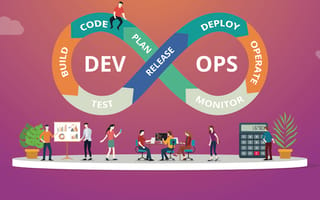DevOps holds a lot of promise for enterprise companies, but it’s not a panacea.
That’s because DevOps isn’t really a “thing.” It’s a set of best practices, team structures and tools that together form a methodology that enables companies to more quickly release software and implement changes and fixes. When executed correctly, DevOps has the potential to take months off the development process.
Companies from an array of industries have touted the time-saving benefits of DevOps in recent years, and while the methodology isn’t a cure-all, companies like Sony Pictures Entertainment KeyBank and UBS have shown DevOps can be transformative when implemented with intention.

Sony Pictures Entertainment
The last-mile delivery challenge: The “ninety-ninety rule” is an old adage coined by Tom Cargill — the creator of C++. It states: “The first 90 percent of the code accounts for the first 90 percent of the development time. The remaining 10 percent of the code accounts for the other 90 percent of the development time.” Cargill came up with the rule back in 1985, but despite advances in technology, it still rings true for many companies today, including Sony Pictures Entertainment (SPE).
A case study by Stelligent, a DevOps consultancy, outlined SPE’s struggle to deliver completed software to users, or the “last mile” of the development process. According to QA testing firm test IO, the last mile is particularly challenging because it’s traditionally the time when companies think the most about risk and do the majority of their testing. At Sony Pictures Entertainment, the last mile added months to the total development time of software delivered by the company’s Digital Media Group (DMG).
From months to minutes: In the case study, DMG worked with Stelligent, a DevOps consultancy, on the delivery of a new version of entertainment asset management software. The two developed a continuous delivery system using Amazon Web Service (AWS) infrastructure that enables software to be automatically tested throughout the development cycle and released with just one click.
The role of open source
- In addition to AWS, the team also used the following open-source tools:
- Chef
- Ruby
- Jenkins
- Cucumber
In the Stelligent case study, Charles Cole, executive director at DMG, told the firm that the new system has enabled his team to spend more time adding new features to software and addressing customer needs.
“With this fully automated approach, we can be more adaptive and responsive to our customers by releasing new features and changes based on business needs in a matter of minutes rather than a multi-month release process,” Cole told Stelligent.

KeyBank
Bringing banks together: In July of 2016, Cleveland-based KeyBank acquired Buffalo-based First Niagara for $4.1 billion in cash and stock. KeyBank gained 300 new branches through the deal and became the 13th-largest bank in the United States at the time. John Rzeszotarski, formerly director of continuous delivery and feedback at KeyBank, told participants at the 2018 European DevOps Enterprise Summit that the acquisition prompted the company to create new online and mobile banking platforms.
Developing new software is easier said than done in the banking industry, primarily because many banks still rely on older technology. A 2017 report from Reuters found that 43 percent of all banks in the United States have systems underpinned by COBOL, a programming language developed in 1959. An anonymous participant at Ernst & Young’s 2019 Bank Governance Leadership Network painted a bleak picture of the technology challenges banks face.
“Financial institutions are museums of technology dating back to the 1960s,” the anonymous participant told EY. “The complexity makes it impossible to manage risk.”
From months to minutes: Given the challenges facing KeyBank, it’s surprising that Rzeszotarski said the company’s new banking platforms were released in a little less than a year. According to Chris McFee, director of enterprise DevOps practices at KeyBank, the key to the project’s success was the use of containers, specifically Kubernetes. McFee detailed the impact of containers on the development of the new banking applications in an article for TechBeacon.
“By using containerization and test automation, we reduced the time it takes to deliver infrastructure from months to minutes,” McFee wrote. “This includes platform-provisioning activities, such as operating system installation, platform installation and configuration, and testing cycles.”
Applications built in Kubernetes run on the same system but are independent of one another, meaning that one application can be updated while others are still running. Along with shaving months off the development of its online banking platforms, Rzeszotarski said containerization also gave KeyBank the ability to make 12 updates to its app in the first four days of its release.

UBS
The digital factory: UBS is the world’s fifth-largest wealth management firm, so when the company releases or updates software, it has to be prepared to field feedback and bug reports from users across the globe.
But logging requests for fixes and new features from users around the world is the easy part. Actually implementing those changes is much more challenging. Christian Bucholdt, UBS’ former head of IT at its digital factory division, told software development news site InfoQ that fixes and changes were delivered at the same time as major software updates — three times a year.
From months to weeks: To address customer feedback and requests more quickly, Bucholdt said UBS created a “digital factory playbook,” which marries Scaled Agile software development practices — an enterprise-specific approach to Agile — and DevOps engineering. The playbook was designed to both increase the speed at which software could be released and ensure that UBS’ global engineering team had a single set of best practices and methodologies to follow.
To spread the playbook’s gospel, Bucholdt said the company conducted thousands of hours of training.
“We have built up an extensive training schedule for the various roles and have trained over 1,000 employees in about 15,000 hours of training,” Bucholdt told InfoQ. “In parallel, agile coaches have been assigned to further embed the operating model in the organization.”
On the technical side, engineers have adopted automated testing and developed decoupled interfaces, or systems that transact but aren’t coupled together and can run and be updated separately. Bucholdt said the playbook and DevOps engineering practices adopted by UBS have given engineers the ability to go from addressing client feedback every four months to every two to four weeks.




